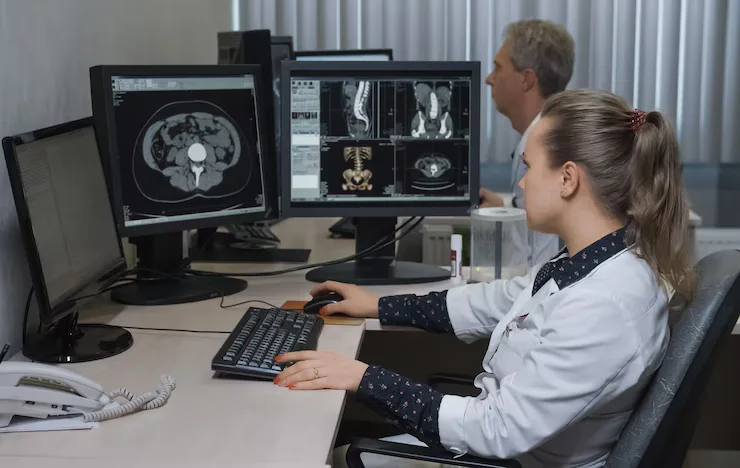Medical imaging is one of the most valuable diagnostic tools in modern healthcare. Whether detecting a fracture, guiding cancer treatment, or identifying neurological conditions, medical scans offer clarity without surgical intervention. Yet, despite their frequent use, public understanding of scans remains incomplete, often shaped by assumptions or misinformation. Here, we address some of the most common misconceptions and explain what medical imaging can and cannot tell us.
Scans Always Detect Everything
One widespread misunderstanding is the belief that any medical scan provides definitive answers. In reality, imaging is only one part of the diagnostic puzzle. An MRI scan may be excellent for visualising soft tissue such as the brain or spinal cord, but it might not detect very small areas of calcification, which a CT scan may highlight more effectively. Similarly, ultrasound excels at assessing organs like the liver or kidneys, but can be less effective in obese patients or where bowel gas obscures the view.
Moreover, the usefulness of a scan depends on the clinical question asked. A radiologist interprets an image based on the context provided by the referring doctor. Without clear background information, even high-resolution images may be inconclusive.
Radiation Exposure Is Always Dangerous
The topic of radiation exposure often causes anxiety. While scans like X-rays and CTs do use ionising radiation, the doses are carefully controlled and kept as low as reasonably achievable. For most people, the level of exposure from a medically necessary scan poses far less risk than the condition being investigated.
Crucially, not all scans involve radiation. MRI and ultrasound are completely radiation-free, making them preferred choices in certain cases, such as during pregnancy or in younger patients where cumulative exposure is a concern.
More Scans Mean Better Care
Another myth is that more scans equal better care. While it may seem reassuring to undergo multiple imaging tests, overuse can lead to overdiagnosis, resulting in unnecessary treatments or further invasive procedures. Additionally, repeated imaging can contribute to higher healthcare costs and increased patient anxiety.
Best practice in medical imaging relies on targeted use. Clinical guidelines help doctors decide when a scan is truly warranted. For instance, CT pulmonary angiography is highly effective in ruling out pulmonary embolism, but only when used in patients with specific risk factors and symptoms.
All Scans Do the Same Thing
It’s a common mistake to view scans as interchangeable tools. In reality, each imaging modality serves a distinct purpose. For example, a PET scan is primarily used to assess metabolic activity, making it especially useful in cancer staging and monitoring treatment response. In contrast, a CT scan offers excellent detail of bony structures and is often used in trauma or acute care settings.
The choice of scan is guided by clinical context—what the doctor is looking for, the patient’s medical history, and the nature of the symptoms. Resources such as Inside Radiology help clarify these distinctions by outlining how each type of imaging is typically used in practice, particularly in more complex areas like cancer diagnosis and follow-up.
Recognising these differences is important not just for clinicians, but also for patients trying to understand their care pathway. When the strengths and limitations of various scans are clearly understood, unnecessary imaging can be avoided, and expectations can be better managed throughout the diagnostic process.
Scan Results Are Instant and Clear
Contrary to popular belief, the process of interpreting scans is not instantaneous. After the scan is performed, a trained radiologist analyses the images, writes a detailed report, and sends it to the referring clinician. This process ensures accurate interpretation, but it may take time, particularly for complex cases that require comparison with previous imaging.
Patients should understand that delays in receiving results do not necessarily indicate bad news; rather, they reflect the care taken to provide accurate, clinically meaningful information.
Scans Are Only for Diagnosing Problems
Medical scans are not limited to diagnosis. They play a crucial role in monitoring disease progression, guiding surgical procedures, and evaluating treatment effectiveness. In oncology, for instance, imaging helps determine tumour size before and after chemotherapy or radiation therapy, and it is also used for surveillance in remission phases.
Furthermore, screening programmes—such as mammography for breast cancer or low-dose CT for lung cancer—use imaging to detect disease at earlier stages, often before symptoms appear.
Why Clear Understanding of Scans Matters
Misconceptions about medical scans can lead to undue stress, misguided expectations, or even unnecessary procedures. Whether you’re a patient trying to make sense of your imaging results or a clinician deciding the best diagnostic route, understanding the purpose and limitations of different scan types is crucial. With accurate knowledge, both professionals and the public are better equipped to make informed decisions, improving outcomes and reducing avoidable risks in care.










 /home/u448362301/domains/theexpotab.com/public_html/wp-content/themes/foxiz/templates/popup.php on line 167
/home/u448362301/domains/theexpotab.com/public_html/wp-content/themes/foxiz/templates/popup.php on line 167